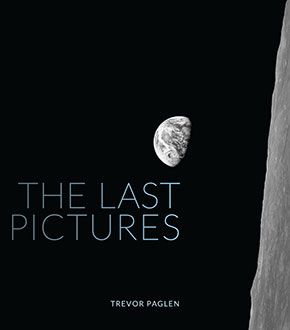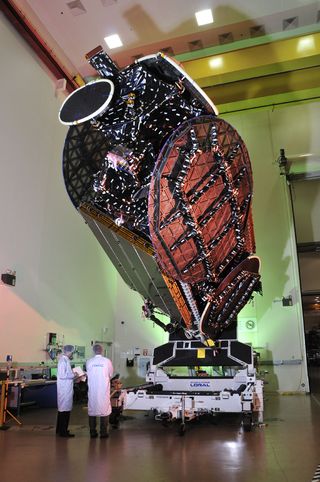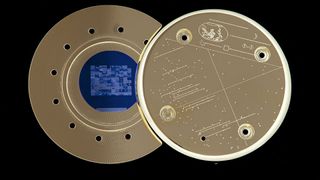
Photo Album of Human History Launched into Space

A new communications spacecraft being hurled into the heavens might seem like ho-hum news, but one particular satellite is carrying what may be one of the longest-lasting material artifacts of contemporary civilization.
Artist Trevor Paglen's "The Last Pictures" is an archival disc containing 100 photographs representing modern human history — a disc affixed to the exterior of the newly lofted EchoStar XVI satellite.
The full artifact attached to the spacecraft is composed of two interlocking gold-plated aluminum jackets housing the silicon disc on which the photographs are nano-etched. The gold-plated shell was designed at the Massachusetts Institute of Technology (MIT) and Carleton College.
And just in case visitors from afar happen upon EchoStar XVI, there's a cover etching, a temporal map consisting of a star chart, pulsar timings and other information describing the epoch from which the spacecraft came. [Art Time Capsule to Live Forever in Space (Video)]

Carleton College astrophysicist Joel Weisberg collaborated with Paglen on the design of the scientific messages to potential discoverers etched into the artifact's cover.
The Last Pictures is a public project presented by New York-based Creative Time, an organization that has worked with more than 2,000 artists to produce hundreds of innovative public art projects. The disc was commissioned by Creative Time.
Nighttime sendoff
Get the Space.com Newsletter
Breaking space news, the latest updates on rocket launches, skywatching events and more!
The EchoStar Corporation's EchoStar XVI satellite, built by Space Systems/Loral, was successfully launched on Nov. 20 from the Baikonur Cosmodrome in Kazakhstan. It launched to orbit by International Launch Services' Proton Breeze M rocket. Ultimately, the spacecraft will be maneuvered into orbit 22,300 miles (35,800 kilometers) above the Earth.
EchoStar XVI will be fully leased to DISH Network for the delivery of direct-to-home broadcast services to DISH customers in the United States.
The EchoStar Corporation donated both the services of its engineers and placement space on its satellite.

Paglen witnessed the nighttime sendoff of his project, telling SPACE.com in an email: "Separation [of the satellite from the rocket] was successful … and the solar panels are deployed and the spacecraft is healthy. Very exciting!!"
"Watching EchoStar XVI and The Last Pictures lift off from Baikonur last night, I was overwhelmed and humbled by the number of people who worked long hours, nights, and weekends, to make this dream of a project come true," Paglen said. "The Last Pictures has gone to space where it will begin a much longer voyage to the depths of time."
Poetic meditation
As a cultural artifact of our time, The Last Pictures is likened to a cosmic message in a bottle to the future and a poetic meditation on the legacy of our civilization.
In selecting the 100 images for the project, Paglen consulted with scientists, artists, philosophers, mathematicians and geologists. His choice of images include depictions of the equipment used in the construction of the atomic bomb; smiling children in a World War II-era Japanese internment camp; as well as a Soyuz rocket launch and the iconic Earthrise image taken during the Apollo 8 mission. [Gallery: Experts' Favorite Space Photos]

"The Last Pictures is a document of this historical moment, but it's not meant to be a representation of humanity … it's not supposed to speak for everybody. It's a very particular kind of document, one person's impression about what the world might look like at this particular moment," Paglen said. "In a way, that's all we can ask out of art … things that help us see who we are now. And the best I can hope for is that this project will give us a way that we can actually look at ourselves."
The complete set of images can be found in "The Last Pictures" book, co-published by Creative Time Books and University of California Press, available from bookstores nationwide and online.
Intersections of art and space
The project was sparked by the idea that high-flying communications satellites will ultimately become the cultural and material ruins of the late 20th and early 21st centuries, far outlasting anything else humans have created.

Paglen said that something very remarkable has happened over the last 50 years: Humans have built a ring around our planet, not unlike the rings of Saturn. But instead of being made out of dust and debris, the ring around Earth that's been created is made out of machines, he said.
The Last Pictures venture is also viewed as part of a long tradition of public intersections of art and space. There are plaques riding on the Pioneer 10 and 11 spacecraft, launched in 1972 and 1973, respectively. Then there's the Frank Drake Arecibo message of 1974, beamed toward star cluster M13 some 25,000 light years away.
Similarly, gold records are affixed to the Voyager spacecraft that departed Earth in 1977, each containing sounds and images portraying the diversity of life on Earth and suggesting the possibility of communicating with extraterrestrial life forms or future humans.
"The Last Pictures acts much like a tombstone or cave painting from a time long forgotten," said Nato Thompson, chief curator for Creative Time.
"Ultimately, The Last Pictures will hover over the Earth in virtual perpetuity," Thompson said, "reminding us — like a haunting shadow — that the greatest hope of lasting communication resides in the tenuous moment of the present."
For more information on Paglen's "The Last Pictures" project, visit: http://creativetime.org/projects/the-last-pictures/
Leonard David has been reporting on the space industry for more than five decades. He is a winner of last year's National Space Club Press Award and a past editor-in-chief of the National Space Society's Ad Astra and Space World magazines. He has written for SPACE.com since 1999.
Join our Space Forums to keep talking space on the latest missions, night sky and more! And if you have a news tip, correction or comment, let us know at: community@space.com.

Leonard David is an award-winning space journalist who has been reporting on space activities for more than 50 years. Currently writing as Space.com's Space Insider Columnist among his other projects, Leonard has authored numerous books on space exploration, Mars missions and more, with his latest being "Moon Rush: The New Space Race" published in 2019 by National Geographic. He also wrote "Mars: Our Future on the Red Planet" released in 2016 by National Geographic. Leonard has served as a correspondent for SpaceNews, Scientific American and Aerospace America for the AIAA. He was received many awards, including the first Ordway Award for Sustained Excellence in Spaceflight History in 2015 at the AAS Wernher von Braun Memorial Symposium. You can find out Leonard's latest project at his website and on Twitter.
